Indoor plants have evolved from simple houseplants to essential design elements that transform living spaces into vibrant, healthy, and visually stunning environments. The art of decorating with plants goes far beyond simply placing a potted plant on a windowsill—it involves understanding how different plants interact with various room conditions, how to style them effectively with complementary containers and stands, and how to maintain them as living decorative elements that enhance your home’s aesthetic appeal. Whether you’re a seasoned plant enthusiast or a complete beginner, mastering the principles of plant decoration will help you create spaces that feel fresh, alive, and beautifully curated.
The transformative power of plants in interior design cannot be overstated. They serve multiple functions simultaneously: purifying the air we breathe, adding natural color and texture to our spaces, creating focal points and visual interest, and bringing a sense of calm and connection to nature into our daily lives. Unlike static decorative objects, plants are dynamic elements that grow, change, and evolve over time, creating living artwork that responds to seasons and care. This dynamic quality makes plant decoration both rewarding and challenging, requiring an understanding of both aesthetic principles and horticultural basics.
Modern interior design increasingly recognizes plants as essential elements rather than optional accessories. The biophilic design movement, which emphasizes our innate connection to nature, has elevated plants from mere decorations to crucial components of healthy, happy living spaces. Research consistently shows that indoor plants reduce stress, improve air quality, boost creativity, and enhance overall well-being. When we decorate with plants, we’re not just improving our homes’ appearance—we’re creating environments that support our physical and mental health.
The key to successful plant decoration lies in understanding that plants are living design elements with specific needs and characteristics. Unlike furniture or artwork that remain static, plants require ongoing care and attention to maintain their decorative value. This means that successful plant decoration must balance aesthetic considerations with practical horticultural requirements. The most beautiful plant arrangement will fail if the plants aren’t suited to their environment or don’t receive proper care.
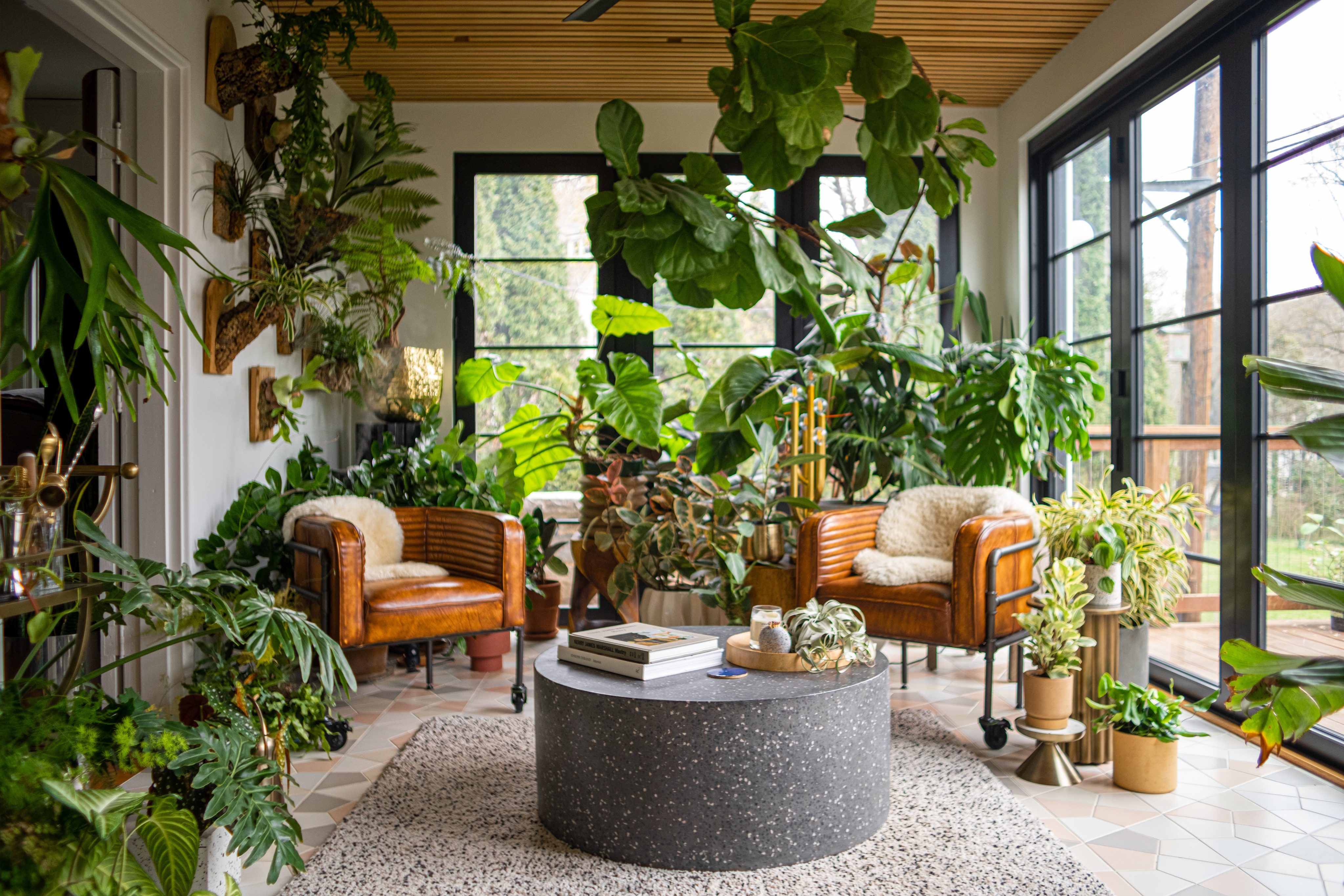
Understanding your space’s unique characteristics—light levels, humidity, temperature fluctuations, and traffic patterns—forms the foundation of successful plant decoration. Each room in your home presents different opportunities and challenges for plant placement, and recognizing these differences will help you select plants that not only look beautiful but thrive in their designated locations. The goal is to create harmonious relationships between plants and their environments, where both the plants and the overall design aesthetic flourish together.
Understanding Light: The Foundation of Plant Selection
Light serves as the most critical factor in plant selection and placement, fundamentally determining which plants will thrive in specific locations throughout your home. Understanding the different types of light conditions and how they affect plant growth will enable you to make informed decisions that ensure both the health of your plants and the success of your decorative arrangements. The relationship between light and plant health directly impacts the visual appeal of your plant decorations, as healthy plants are inherently more beautiful and effective as design elements.
Natural light varies dramatically throughout your home, influenced by window orientation, surrounding buildings or trees, seasonal changes, and the time of day. South-facing windows typically receive the most intense, direct sunlight throughout the day, making them ideal for sun-loving plants like succulents, cacti, and many flowering varieties. However, this intense light can also be overwhelming for plants accustomed to shadier conditions, potentially causing leaf burn or stress that diminishes their decorative value.
East-facing windows provide gentle morning sunlight followed by bright, indirect light for the remainder of the day. This combination makes east-facing locations ideal for a wide variety of plants, including many popular houseplants like pothos, philodendrons, and peace lilies. The morning sun provides energy for photosynthesis without the harsh intensity of afternoon sun, creating optimal growing conditions that translate into lush, healthy plants that enhance your decor.
West-facing windows receive intense afternoon and evening sun, which can be challenging for many houseplants. The heat and intensity of western exposure often require careful plant selection, favoring varieties that can tolerate higher temperatures and more intense light. However, this exposure can be excellent for plants that enjoy warmth and bright light, such as certain palms, rubber trees, and some flowering plants.
North-facing windows provide the most consistent but lowest light levels, creating ideal conditions for shade-tolerant plants. Many popular houseplants actually prefer these lower light conditions, including snake plants, ZZ plants, and various ferns. Understanding that lower light doesn’t mean no decorative potential helps you appreciate the beauty of shade-loving plants and their unique contributions to your home’s aesthetic.
Artificial lighting can supplement or replace natural light in areas where you want to include plants but natural light is insufficient. Modern LED grow lights are increasingly sophisticated and can be integrated into your decor in ways that enhance rather than detract from your design aesthetic. Understanding how to use artificial lighting effectively expands your options for plant placement and allows you to create stunning plant displays in previously unsuitable locations.
The quality and intensity of light change throughout the day and seasons, affecting both plant health and the visual impact of your plant arrangements. Morning light tends to be cooler and less intense, while afternoon light is warmer and more powerful. Seasonal changes dramatically affect light levels, with winter months providing significantly less light than summer months. Successful plant decoration requires understanding these variations and either selecting plants that can adapt to changing conditions or being prepared to move plants seasonally to maintain their health and appearance.
Observing and understanding the light patterns in your home takes time and attention, but this knowledge forms the foundation of all successful plant decoration. Spend time in different rooms at various times of day, noting where light falls, how intense it becomes, and how it changes throughout the day. This observation will guide your plant selection and placement decisions, ensuring that your decorative arrangements are built on a foundation of horticultural success.
Room-by-Room Plant Selection Guide
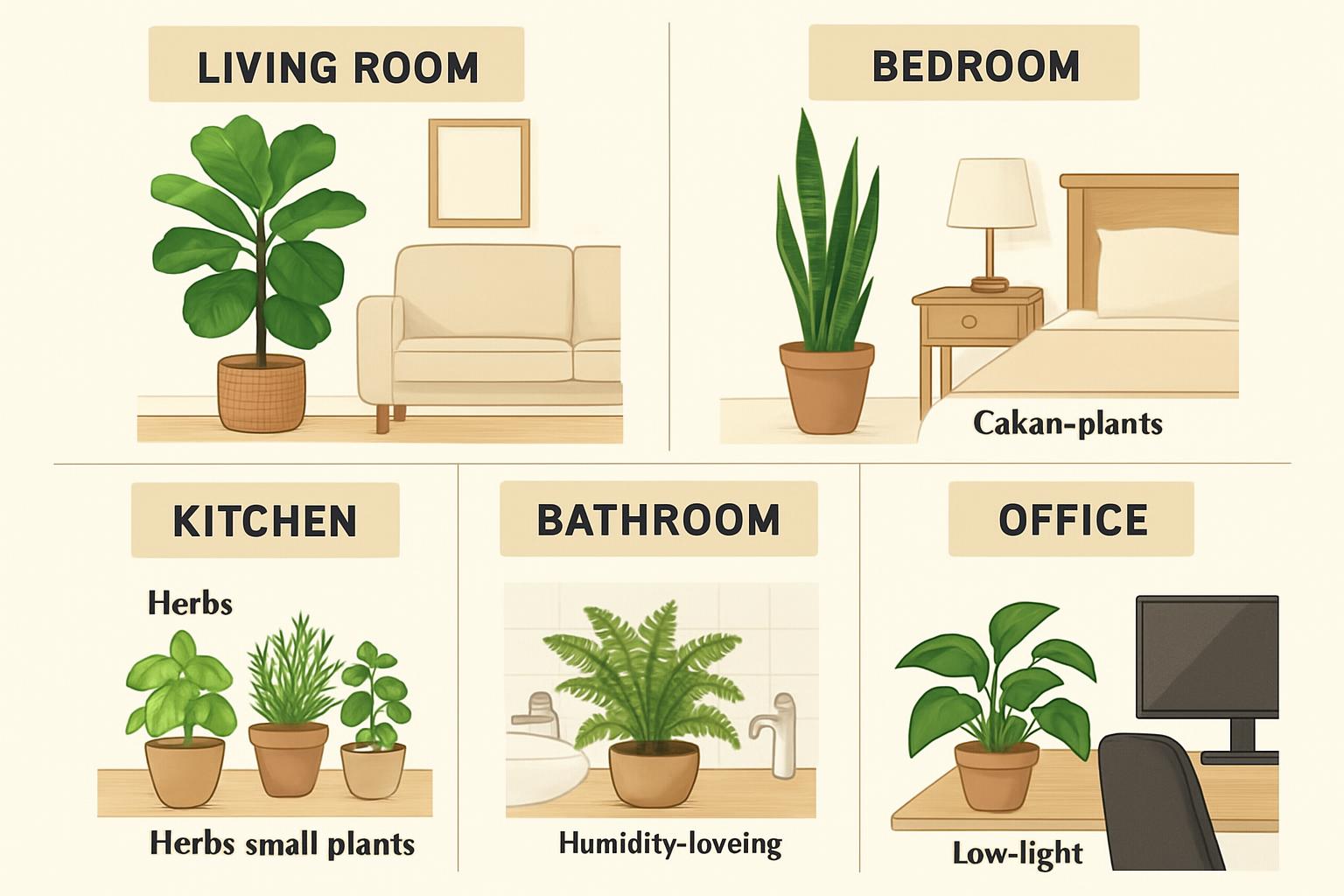
Each room in your home presents unique opportunities and challenges for plant decoration, with different environmental conditions, functional requirements, and aesthetic goals that influence plant selection and styling decisions. Understanding how to choose and style plants for specific rooms will help you create cohesive, functional, and beautiful plant displays that enhance each space’s unique character while meeting the practical needs of both the plants and the room’s occupants.
The living room, as the primary gathering space in most homes, offers the greatest opportunity for dramatic plant statements and diverse plant arrangements. This room typically receives good natural light from multiple windows and has the space to accommodate larger plants that can serve as focal points or architectural elements. Consider using large floor plants like fiddle leaf figs, bird of paradise, or large palms to create vertical interest and natural sculptures that complement your furniture arrangement.
Living rooms benefit from layered plant arrangements that create depth and visual interest at multiple levels. Combine tall floor plants with medium-sized plants on stands or tables, and smaller plants on shelves or side tables to create a rich, varied landscape that feels natural and abundant. The key is to create groupings that feel intentional rather than scattered, using odd numbers of plants and varying heights to create pleasing compositions.
The social nature of living rooms makes them ideal for plants that can tolerate some disturbance and don’t require extremely specific care conditions. Hardy plants like rubber trees, monstera deliciosa, or snake plants can withstand the occasional bump or touch while maintaining their decorative appeal. Consider the traffic patterns in your living room when placing plants, ensuring that they enhance rather than obstruct the room’s functionality.
Bedrooms require special consideration for plant selection, as they serve as personal retreats focused on rest and relaxation. Choose plants known for their air-purifying qualities and calming presence, such as snake plants, peace lilies, or lavender. Avoid plants with strong fragrances that might interfere with sleep, and consider the bedroom’s typically lower light levels when making selections.
The bedroom’s intimate scale often works best with smaller to medium-sized plants that create a sense of tranquility without overwhelming the space. Bedside tables can accommodate small plants like pothos or small succulents, while dressers or windowsills might hold slightly larger specimens. Consider hanging plants in bedrooms with high ceilings to add greenery without taking up valuable floor or surface space.
Kitchens present unique opportunities for both decorative and functional plant arrangements. Herbs like basil, rosemary, thyme, and mint serve dual purposes as both decorative elements and culinary ingredients. The kitchen’s typically good light and easy access to water make it an ideal location for plants that require regular attention and care.
Kitchen plant arrangements should consider the room’s functional requirements and potential exposure to cooking heat, steam, and grease. Choose plants that can tolerate these conditions and place them where they won’t interfere with food preparation or cooking activities. Windowsill herb gardens, hanging plants over islands or peninsulas, and small plants on open shelving can all work well in kitchen environments.
Bathrooms offer unique growing conditions with higher humidity levels that many plants love, but they often have lower light levels that limit plant options. Ferns, air plants, and certain orchids thrive in bathroom conditions, appreciating the humidity while tolerating lower light. The bathroom’s smaller scale typically works best with smaller plants that can fit on counters, shelves, or in shower niches.
Consider the bathroom’s functional requirements when placing plants, ensuring they don’t interfere with daily routines or create maintenance challenges. Plants that enjoy humidity but don’t require frequent watering work well in bathrooms, as the ambient moisture often reduces their watering needs.
Home offices and workspaces benefit from plants that can improve air quality and provide visual relief from screens and work stress. Choose low-maintenance plants that won’t require attention during work hours, such as snake plants, ZZ plants, or small succulents. The office environment often has consistent lighting and temperature, making it suitable for a wide variety of plants.
Consider the psychological benefits of plants in work environments when making selections. Plants with interesting textures or forms can provide visual interest and mental breaks, while air-purifying varieties can improve the overall work environment. Avoid plants that require frequent care or attention during work hours, as this can become distracting rather than beneficial.
The Art of Pot Selection and Styling
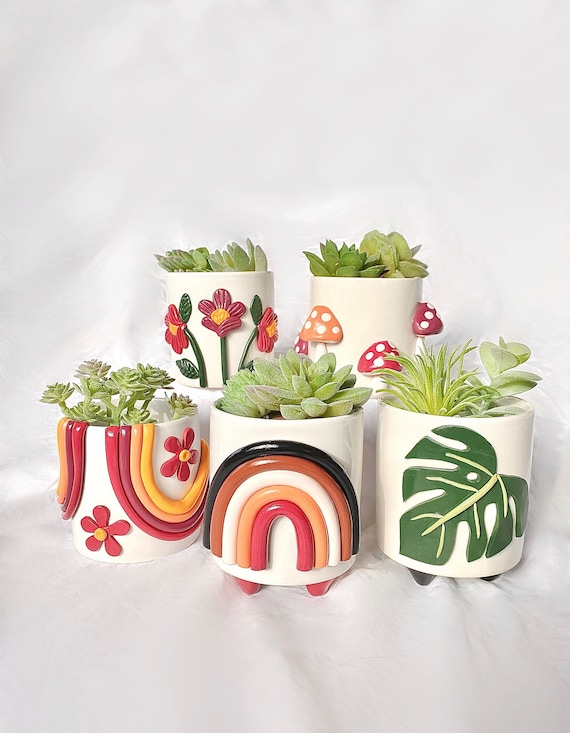
The containers you choose for your plants play a crucial role in both their health and their decorative impact, serving as the bridge between the natural beauty of the plants and the designed aesthetic of your home. Successful pot selection requires balancing practical considerations like drainage, size, and material properties with aesthetic factors like color, texture, and style compatibility. The right pot can elevate a simple plant into a stunning decorative element, while the wrong choice can diminish even the most beautiful specimen.
Understanding the relationship between pot size and plant health forms the foundation of successful container selection. Pots that are too small restrict root growth and require frequent watering, while oversized containers can lead to waterlogged soil and root rot. The general rule suggests choosing pots that are 1-2 inches larger in diameter than the plant’s current container, allowing room for growth without overwhelming the root system. However, decorative considerations sometimes require creative solutions, such as using cache pots or decorative outer containers that house properly sized growing pots.
Drainage represents the most critical functional aspect of pot selection, as proper water management is essential for plant health and longevity. Pots without drainage holes can work for certain plants or with careful watering techniques, but they require more attention and skill to manage successfully. When using decorative pots without drainage, consider using them as cache pots with properly draining inner containers, or add drainage layers using gravel or activated charcoal to prevent water accumulation.
Material choice significantly impacts both the aesthetic and functional performance of plant containers. Terracotta and unglazed ceramic pots provide excellent drainage and allow air circulation to roots, making them ideal for plants that prefer drier conditions. However, their porous nature means they dry out more quickly and may not suit plants that prefer consistent moisture. The natural, earthy appearance of terracotta works well with casual, organic design styles but may not suit more formal or contemporary aesthetics.
Glazed ceramic pots offer more design flexibility with various colors, patterns, and finishes while providing better moisture retention than unglazed options. The non-porous surface makes them easier to clean and maintain, and the wide variety of available styles makes them suitable for almost any design aesthetic. However, glazed pots typically lack the breathability that some plants prefer, making them better suited for plants that enjoy consistent moisture.
Plastic and resin pots have evolved significantly in recent years, with many options that convincingly mimic natural materials while offering practical advantages like lighter weight and better durability. High-quality plastic pots can provide excellent drainage and root aeration while being easier to move and less prone to breakage. However, cheaper plastic options may not provide adequate drainage or may degrade quickly when exposed to sunlight.
Metal containers, including copper, brass, and steel options, can create striking modern or industrial looks but require careful consideration of their impact on plant health. Metal containers can heat up quickly in direct sunlight, potentially damaging roots, and some metals may react with soil or fertilizers over time. Using metal containers as cache pots with proper inner containers often provides the best balance of aesthetic appeal and plant health.
Natural materials like woven baskets, wooden planters, and stone containers can create beautiful organic looks that complement plant materials perfectly. However, these materials often require special treatment or liners to prevent water damage and ensure longevity. Understanding how to properly prepare and maintain natural material containers will help you achieve beautiful results while protecting your investment.
Color coordination between pots and your existing decor helps create cohesive, intentional-looking plant arrangements. Neutral colors like white, cream, gray, and natural terracotta work well with most design styles and allow the plants to be the focal point. Bold or colorful pots can create striking statements but should be used carefully to avoid overwhelming the space or clashing with existing color schemes.
The scale and proportion of pots relative to both the plants they contain and the spaces they occupy significantly impact their decorative effectiveness. Large plants in small pots look unstable and unbalanced, while small plants in oversized containers can appear lost and insignificant. Consider the visual weight of both the plant and container when making selections, aiming for combinations that feel balanced and proportionate.
Grouping pots of different sizes, materials, or colors can create dynamic, interesting displays that have more impact than individual containers. However, successful groupings require careful attention to creating visual harmony through repeated elements like color, material, or style. Odd numbers of containers typically create more pleasing arrangements than even numbers, and varying heights adds visual interest and depth to groupings.
Plant Stands and Display Solutions
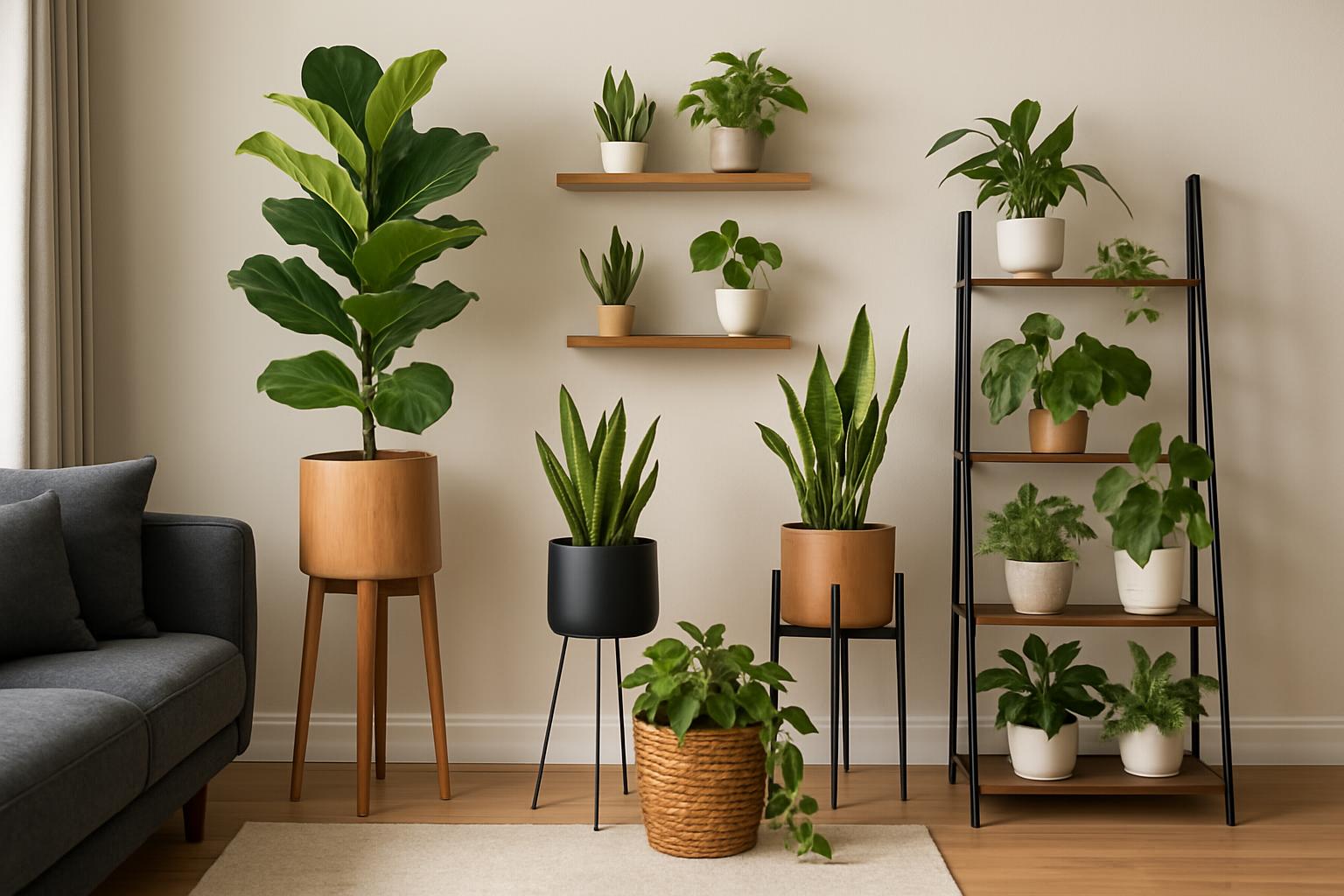
Elevating plants through the use of stands, shelves, and other display solutions dramatically expands your decorating possibilities while creating more dynamic, layered plant arrangements that add depth and visual interest to your spaces. Plant stands serve both practical and aesthetic functions, improving plant health by providing better light exposure and air circulation while creating opportunities for more sophisticated styling that integrates seamlessly with your existing furniture and decor.
The variety of plant stand styles available today means you can find options that complement any design aesthetic, from minimalist modern to rustic farmhouse to mid-century modern. Wooden plant stands offer warmth and natural beauty that complements plant materials perfectly, with options ranging from simple tripod designs to elaborate tiered structures. The wood species, finish, and construction style can dramatically affect the overall aesthetic impact, making it important to consider how the stand will integrate with your existing furniture and decor.
Metal plant stands provide opportunities for more contemporary or industrial looks, with materials like brass, copper, steel, and iron offering different aesthetic qualities. Brass and copper develop beautiful patinas over time, adding character and warmth to plant displays. Steel and iron can provide sleek, modern looks or rustic, industrial appeal depending on their finish and design. The durability of metal stands makes them excellent choices for heavier plants or high-traffic areas.
Woven and natural material stands, including rattan, bamboo, and wicker options, create casual, organic looks that work particularly well with bohemian or coastal design styles. These materials add texture and visual interest while maintaining the natural, organic feeling that complements plant materials. However, natural material stands may require more maintenance and care to prevent damage from moisture or wear.
The height and scale of plant stands significantly impact their effectiveness in creating layered, dynamic plant displays. Varying heights creates visual rhythm and allows you to showcase plants at different levels, making better use of vertical space while creating more interesting compositions. Consider how the stand height will affect the plant’s access to light and how it will integrate with your existing furniture heights.
Multi-tiered plant stands and ladder-style displays allow you to showcase multiple plants in a compact footprint, making them ideal for smaller spaces or areas where you want to create significant plant impact without using extensive floor space. These displays work particularly well with collections of smaller plants or when you want to create a plant focal point in a specific area.
Wall-mounted plant displays and floating shelves provide opportunities to add greenery without using any floor space, making them ideal for small rooms or areas where floor space is at a premium. These solutions work particularly well for trailing plants that can cascade down from elevated positions, creating beautiful living curtains or natural room dividers.
Hanging plant displays, including ceiling-mounted hooks, wall brackets, and freestanding hanging systems, add plants at eye level and above, creating more immersive plant environments. Hanging displays work particularly well for trailing plants like pothos, string of pearls, or spider plants that can create beautiful cascading effects. Consider the weight of plants when selecting hanging hardware, and ensure that ceiling or wall mounting points can safely support the load.
Plant carts and mobile displays provide flexibility to move plants as needed for care, cleaning, or seasonal light changes. These solutions work particularly well in spaces where you might want to rearrange frequently or where plants need to be moved for parties or other activities. Rolling carts can also serve dual purposes, providing plant display space along with storage for plant care supplies.
The integration of plant displays with existing furniture and architectural elements creates more sophisticated, built-in looks that feel intentional and designed rather than added as afterthoughts. Consider how plant stands and displays can work with your existing bookcases, side tables, and other furniture to create cohesive, layered arrangements that feel natural and unforced.
Lighting considerations become particularly important when using plant stands and elevated displays, as raising plants can significantly change their light exposure. Ensure that elevated plants still receive appropriate light for their needs, and consider how the stands themselves might cast shadows or block light for other plants or areas of the room.
Essential Plant Care for Decorative Success
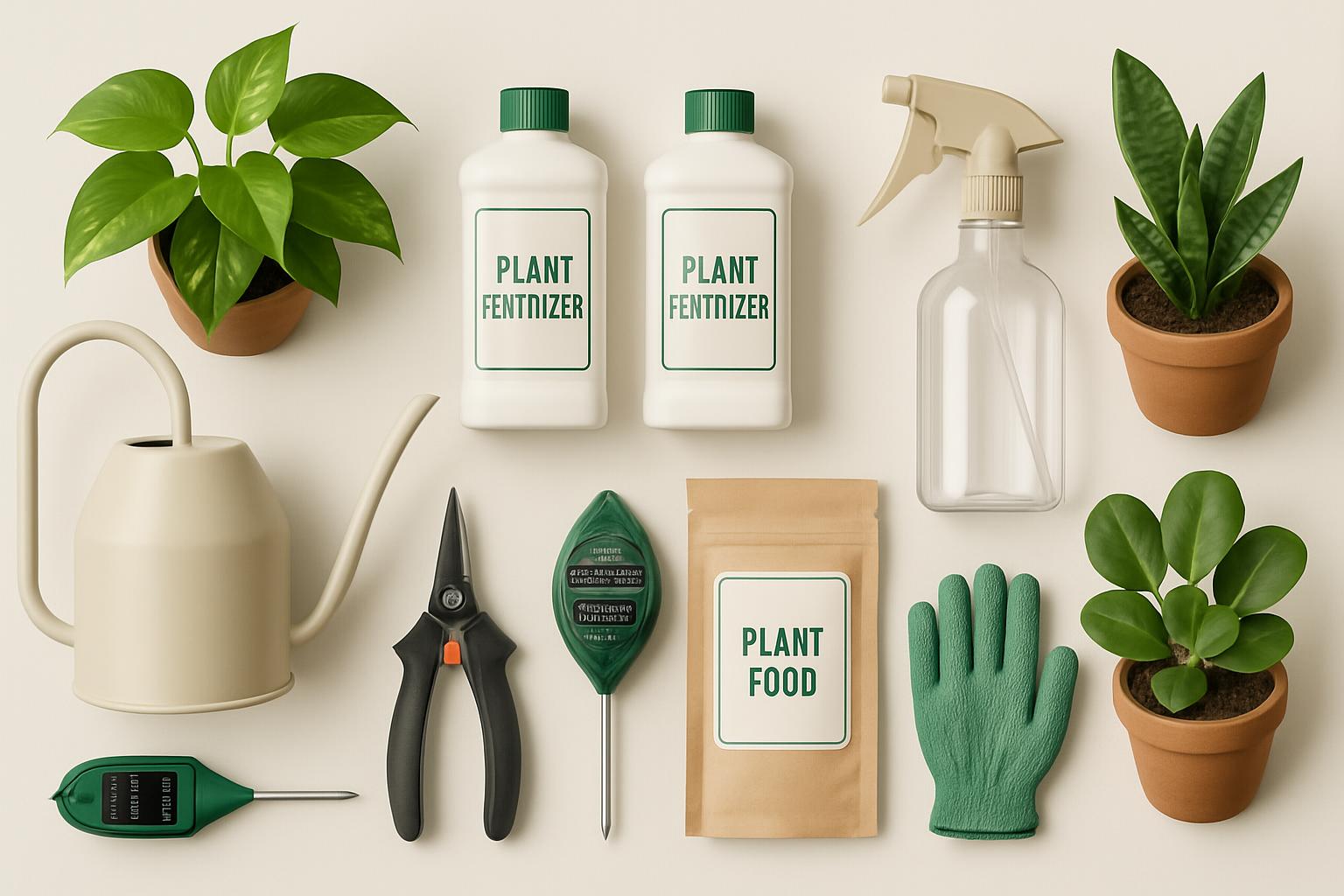
Maintaining plants as decorative elements requires understanding that their beauty and effectiveness as design components depend entirely on their health and vitality. Healthy plants are inherently more attractive, with vibrant colors, strong growth patterns, and the robust appearance that makes them effective decorative elements. Developing consistent, appropriate care routines ensures that your plant investments continue to enhance your home’s aesthetic appeal while providing the air purification and psychological benefits that make plant decoration so rewarding.
Watering represents the most fundamental aspect of plant care, yet it’s also the area where most plant owners make critical mistakes that compromise both plant health and decorative appeal. Understanding that different plants have vastly different water requirements helps you develop appropriate watering schedules and techniques that keep each plant thriving. Overwatering kills more houseplants than underwatering, making it essential to understand each plant’s specific needs and to develop techniques for assessing when watering is actually needed.
The finger test provides a simple, reliable method for assessing soil moisture levels in most plants. Insert your finger 1-2 inches into the soil near the edge of the pot, away from the plant stem. If the soil feels dry at this depth, most plants are ready for watering. If the soil still feels moist, wait a few more days before checking again. This technique helps you develop an intuitive understanding of your plants’ water needs while preventing the overwatering that leads to root rot and plant decline.
Water quality can significantly impact plant health, particularly for sensitive varieties or in areas with heavily treated municipal water. Chlorinated water can stress some plants, while water that’s too hard or soft can affect nutrient uptake and overall plant health. Allowing tap water to sit overnight before using it for plants helps chlorine evaporate, while collecting rainwater provides an excellent natural alternative for sensitive plants.
Proper watering technique involves thoroughly saturating the soil until water drains from the bottom of the pot, ensuring that the entire root system receives moisture. Shallow, frequent watering encourages roots to stay near the surface, making plants more susceptible to stress and less resilient overall. Deep, less frequent watering encourages strong root development and creates more resilient plants that better maintain their decorative appeal.
Fertilizing provides plants with the nutrients they need to maintain healthy growth and vibrant appearance, but understanding when and how to fertilize prevents the problems that come from over-fertilization. Most houseplants benefit from regular feeding during their active growing season, typically spring through early fall, with reduced or eliminated feeding during winter months when growth naturally slows.
Liquid fertilizers provide immediate nutrient availability and allow for precise control over feeding schedules and concentrations. Diluting liquid fertilizers to half the recommended strength and feeding more frequently often provides better results than full-strength monthly feeding, as it provides consistent nutrition without the risk of fertilizer burn that can damage roots and foliage.
Slow-release fertilizers provide consistent nutrition over extended periods, making them convenient for busy plant owners or for plants that prefer steady, consistent feeding. These fertilizers work particularly well for plants in larger containers or for those that don’t require frequent repotting, as they provide nutrition for several months with a single application.
Pruning and grooming maintain plants’ decorative appeal while promoting healthy growth patterns that enhance their aesthetic value. Regular removal of dead, damaged, or yellowing leaves keeps plants looking their best while preventing the spread of disease or pest problems. Understanding how to prune different types of plants helps you maintain their natural growth patterns while encouraging the full, healthy appearance that makes them effective decorative elements.
Pinching growing tips on many plants encourages bushier, fuller growth that creates more attractive, substantial-looking specimens. This technique works particularly well for plants like pothos, philodendrons, and many herbs, creating fuller, more decorative plants that have greater visual impact in your arrangements.
Cleaning plant leaves maintains their ability to photosynthesize effectively while keeping them looking their best as decorative elements. Dust accumulation on leaves reduces their efficiency and makes plants look dull and unhealthy. Gentle wiping with a damp cloth or occasional gentle showers helps maintain the vibrant, healthy appearance that makes plants effective decorative elements.
Pest monitoring and management prevents small problems from becoming major issues that compromise both plant health and decorative appeal. Regular inspection of plants during routine care helps you identify pest problems early when they’re easier to treat and before they spread to other plants. Understanding common houseplant pests and their treatments helps you maintain healthy, attractive plants that continue to enhance your home’s aesthetic appeal.
Repotting provides plants with fresh soil and appropriate container sizes that support continued healthy growth and attractive appearance. Most houseplants benefit from repotting every 1-3 years, depending on their growth rate and current container size. Understanding when and how to repot plants helps you maintain their health and decorative value while providing opportunities to update containers to better match your evolving design aesthetic.
Creating Plant Groupings and Arrangements
The art of creating effective plant groupings and arrangements involves understanding principles of design composition while considering the practical needs and growth habits of different plant species. Successful plant arrangements create visual harmony and interest through careful attention to scale, proportion, color, texture, and form, while ensuring that all plants in the grouping have compatible care requirements that allow them to thrive together. Mastering these principles enables you to create stunning plant displays that serve as living artwork in your home.
The rule of odds applies powerfully to plant arrangements, with groupings of three, five, or seven plants typically creating more visually pleasing compositions than even numbers. Odd-numbered groupings feel more natural and dynamic, avoiding the static, symmetrical feeling that even numbers can create. This principle works at multiple scales, from small tabletop arrangements to large floor displays that incorporate multiple plant stands and containers.
Varying heights within plant groupings creates visual rhythm and depth that makes arrangements more interesting and dynamic. Combine tall, medium, and short plants to create layered compositions that draw the eye through the arrangement and create a sense of natural abundance. This height variation can be achieved through the plants themselves, through different container sizes, or through the use of plant stands and risers that elevate some plants above others.
Texture contrast adds visual interest and sophistication to plant arrangements, preventing them from appearing monotonous or flat. Combine plants with different leaf shapes, sizes, and surface textures to create rich, varied compositions that engage the eye and invite closer inspection. Pair broad-leafed plants like fiddle leaf figs with fine-textured plants like ferns, or combine smooth, glossy leaves with rough, textured surfaces for maximum visual impact.
Color coordination within plant groupings helps create cohesive arrangements that feel intentional and designed rather than randomly assembled. While most houseplants feature various shades of green, the subtle variations in green tones, along with different leaf patterns and occasional flowering or colorful foliage, provide opportunities for sophisticated color coordination. Consider how different green tones work together, and use plants with variegated or colored foliage as accent elements within predominantly green arrangements.
Form and growth habit diversity creates more interesting and natural-looking plant groupings that avoid the monotony of similar plant shapes. Combine upright, architectural plants with trailing varieties and bushy, full specimens to create compositions that feel balanced and complete. Understanding how different plant forms work together helps you create arrangements that feel natural and harmonious while providing visual interest and variety.
Scale relationships between plants and their containers, as well as between different plants within groupings, significantly impact the success of plant arrangements. Ensure that plant sizes feel proportionate to their containers and that different plants within groupings complement rather than compete with each other. Avoid placing tiny plants next to massive specimens unless you’re intentionally creating dramatic scale contrasts for specific design effects.
Seasonal considerations affect both the appearance and care requirements of plant groupings, making it important to plan arrangements that can adapt to changing conditions throughout the year. Consider how different plants respond to seasonal light changes, temperature fluctuations, and humidity variations when creating groupings. Plants with similar seasonal responses work better together in groupings than those with dramatically different seasonal needs.
Maintenance accessibility ensures that plant groupings remain practical and sustainable over time. Arrange plants so that each specimen can be easily accessed for watering, pruning, and general care without disturbing other plants in the grouping. Consider how the arrangement will look and function as plants grow and change over time, planning for the eventual size and shape of mature specimens.
Traffic flow and room function influence the placement and design of plant groupings, ensuring that they enhance rather than obstruct the use of your spaces. Consider how people move through rooms and where they spend time when planning plant arrangements. Groupings should feel welcoming and accessible rather than creating barriers or obstacles to normal room use.
The background and surrounding elements significantly impact the effectiveness of plant groupings, with neutral backgrounds typically showcasing plants more effectively than busy or competing patterns. Consider how wall colors, furniture, and other decorative elements will interact with your plant arrangements, and plan groupings that complement rather than compete with existing design elements.
Troubleshooting Common Plant Problems
Understanding how to identify and address common plant problems quickly and effectively ensures that your decorative plants maintain their health and beauty over time. Most plant problems are preventable through proper care and environmental management, but when issues do arise, prompt identification and appropriate treatment can often restore plants to full health and decorative value. Developing troubleshooting skills helps you maintain beautiful plant displays while building confidence in your plant care abilities.
Yellowing leaves represent one of the most common plant problems, with multiple potential causes that require different treatment approaches. Overwatering is the most frequent cause of yellowing leaves, as waterlogged soil prevents roots from accessing oxygen and leads to root rot that manifests as yellowing foliage. If yellowing leaves feel soft and mushy, and the soil remains consistently wet, reduce watering frequency and ensure proper drainage to address the problem.
Underwatering can also cause yellowing leaves, but these typically feel dry and crispy rather than soft and mushy. If the soil feels very dry and pulls away from the pot edges, increase watering frequency and ensure that water penetrates throughout the soil mass rather than running off the surface. Establishing consistent watering routines helps prevent both overwatering and underwatering problems.
Natural aging causes lower leaves to yellow and drop as plants redirect energy to new growth, and this process is normal and not cause for concern. However, if yellowing affects multiple leaves or newer growth, investigate other potential causes like nutrient deficiencies, pest problems, or environmental stress.
Brown leaf tips and edges often indicate low humidity, inconsistent watering, or fertilizer burn from over-fertilization. Increasing humidity around plants through grouping, pebble trays, or humidifiers can address humidity-related browning. Ensuring consistent soil moisture without waterlogging helps prevent water stress that leads to brown edges. If over-fertilization is suspected, flush the soil with plain water to remove excess salts.
Pest problems can quickly compromise both plant health and decorative appeal, making early identification and treatment essential. Common houseplant pests include spider mites, aphids, scale insects, and mealybugs, each requiring different treatment approaches. Regular inspection during routine plant care helps identify pest problems before they become severe and spread to other plants.
Spider mites typically appear as tiny moving specks on leaf undersides, often accompanied by fine webbing and stippled or yellowing leaves. These pests thrive in dry conditions, so increasing humidity and ensuring adequate watering can help prevent infestations. Treatment options include insecticidal soap, neem oil, or simply washing plants with a strong water spray to remove mites.
Aphids appear as small, soft-bodied insects that cluster on new growth and leaf undersides, often causing leaves to curl or become distorted. These pests can multiply rapidly but are relatively easy to treat with insecticidal soap, neem oil, or beneficial insects like ladybugs. Regular inspection and prompt treatment prevent aphid populations from becoming established.
Scale insects appear as small, brown or white bumps on stems and leaves, often causing yellowing and weakening of affected plants. These pests can be difficult to treat once established, making prevention and early intervention crucial. Treatment typically involves physically removing visible scales and applying systemic insecticides or horticultural oils to eliminate remaining pests.
Fungal problems often result from excessive moisture, poor air circulation, or contaminated soil, appearing as spots, patches, or fuzzy growth on leaves or soil surfaces. Improving air circulation, reducing watering frequency, and removing affected plant parts can help control fungal issues. Fungicidal treatments may be necessary for severe infections, but prevention through proper care is more effective than treatment.
Environmental stress from sudden changes in light, temperature, or humidity can cause various plant problems including leaf drop, wilting, or stunted growth. Plants typically adapt to gradual environmental changes but may struggle with sudden shifts. When moving plants or changing their care routines, make adjustments gradually to minimize stress and allow plants time to adapt.
Root problems, including root rot from overwatering or root binding from overgrown containers, can cause various above-ground symptoms including yellowing leaves, wilting, or stunted growth. Checking root health during repotting helps identify these problems early, and addressing root issues often resolves mysterious plant problems that don’t respond to other treatments.
Recovery strategies for stressed or damaged plants focus on providing optimal care conditions while allowing time for natural healing and regrowth. This often means reducing stress factors, providing consistent care, and being patient as plants recover their health and decorative appeal. Understanding that plant recovery takes time helps you maintain realistic expectations while providing the consistent care that supports healing.
Seasonal Plant Care and Rotation
Understanding how seasonal changes affect indoor plants and adjusting care routines accordingly ensures that your decorative plants remain healthy and attractive throughout the year. Indoor plants experience seasonal variations in light, temperature, and humidity even in climate-controlled homes, and recognizing these changes allows you to provide appropriate care that maintains their decorative value while supporting their natural growth cycles. Developing seasonal care awareness helps you anticipate and prevent problems while maximizing your plants’ health and beauty.
Spring represents the beginning of the active growing season for most houseplants, as increasing daylight hours and warmer temperatures stimulate new growth and increased activity. This is typically the best time for repotting, fertilizing, and propagating plants, as their natural growth energy supports recovery from these potentially stressful activities. Spring care routines should focus on supporting this renewed growth while gradually increasing care intensity after the dormant winter period.
Increasing watering frequency gradually as plants begin active growth prevents shock while meeting their increased water needs. Monitor soil moisture more frequently as plants begin using water more quickly, but avoid sudden dramatic increases in watering that can overwhelm dormant root systems. The transition from winter to spring care should be gradual and responsive to individual plant needs rather than following rigid schedules.
Fertilizing resumes in spring as plants begin active growth and can effectively utilize additional nutrients. Start with diluted fertilizer solutions and gradually increase to full strength as plants demonstrate active growth. This gradual approach prevents fertilizer burn while providing the nutrition that supports healthy spring growth and attractive appearance.
Summer brings peak growing conditions for most houseplants, with maximum daylight hours and warm temperatures supporting vigorous growth and development. However, summer also brings challenges including increased heat, potential air conditioning effects, and vacation care considerations that require attention to maintain plant health and decorative appeal.
Increased watering frequency becomes necessary as plants actively grow and higher temperatures increase evaporation rates. Monitor plants more frequently during hot weather, as soil can dry out much more quickly than during cooler seasons. However, maintain proper drainage and avoid waterlogging, as warm, wet conditions can promote fungal problems and root rot.
Heat stress can affect plants near windows or in rooms that become very warm during summer months. Providing additional humidity, ensuring adequate air circulation, and potentially moving plants away from heat sources helps prevent stress that can compromise their decorative appeal. Understanding your home’s summer heat patterns helps you anticipate and prevent heat-related problems.
Vacation care planning becomes essential during summer travel seasons, as plants cannot tolerate neglect during their active growing period. Options include automatic watering systems, plant sitters, or temporary relocation to cooler, more humid locations that reduce water needs. Planning ahead ensures that plants remain healthy and attractive despite temporary care interruptions.
Fall signals the beginning of the transition to dormancy for many plants, as decreasing daylight hours and cooler temperatures slow growth and reduce care requirements. This transition period requires gradual adjustments to care routines that support plants’ natural preparation for winter dormancy while maintaining their health and appearance.
Reducing fertilizer frequency and strength helps plants prepare for dormancy without encouraging tender new growth that may be damaged by winter conditions. Most plants benefit from stopping fertilization entirely by late fall, allowing them to naturally slow their growth and prepare for the dormant winter period.
Watering frequency typically decreases as plants slow their growth and use less water, but the transition should be gradual and responsive to individual plant needs. Monitor soil moisture carefully during the fall transition, as plants’ water needs can change relatively quickly as they respond to environmental cues.
Winter represents the dormant period for most houseplants, with reduced light, lower humidity from heating systems, and generally slower growth requiring adjusted care routines. Understanding that most plants naturally slow their growth during winter helps you provide appropriate care that maintains their health without forcing unwanted growth during unfavorable conditions.
Reduced watering frequency reflects plants’ decreased water needs during dormancy, but maintaining appropriate soil moisture remains important for plant health. Allow soil to dry more thoroughly between waterings, but avoid allowing plants to become completely dehydrated. The balance between adequate moisture and avoiding overwatering becomes particularly important during winter months.
Humidity management becomes crucial during winter months when heating systems significantly reduce indoor humidity levels. Grouping plants together, using pebble trays, or running humidifiers helps maintain the humidity levels that keep plants healthy and attractive during the dry winter months.
Light supplementation may become necessary in areas with limited winter daylight, particularly for plants that require bright light to maintain their decorative appeal. Grow lights can supplement natural light and help plants maintain their health and appearance during the darkest months of the year.
Advanced Styling Techniques
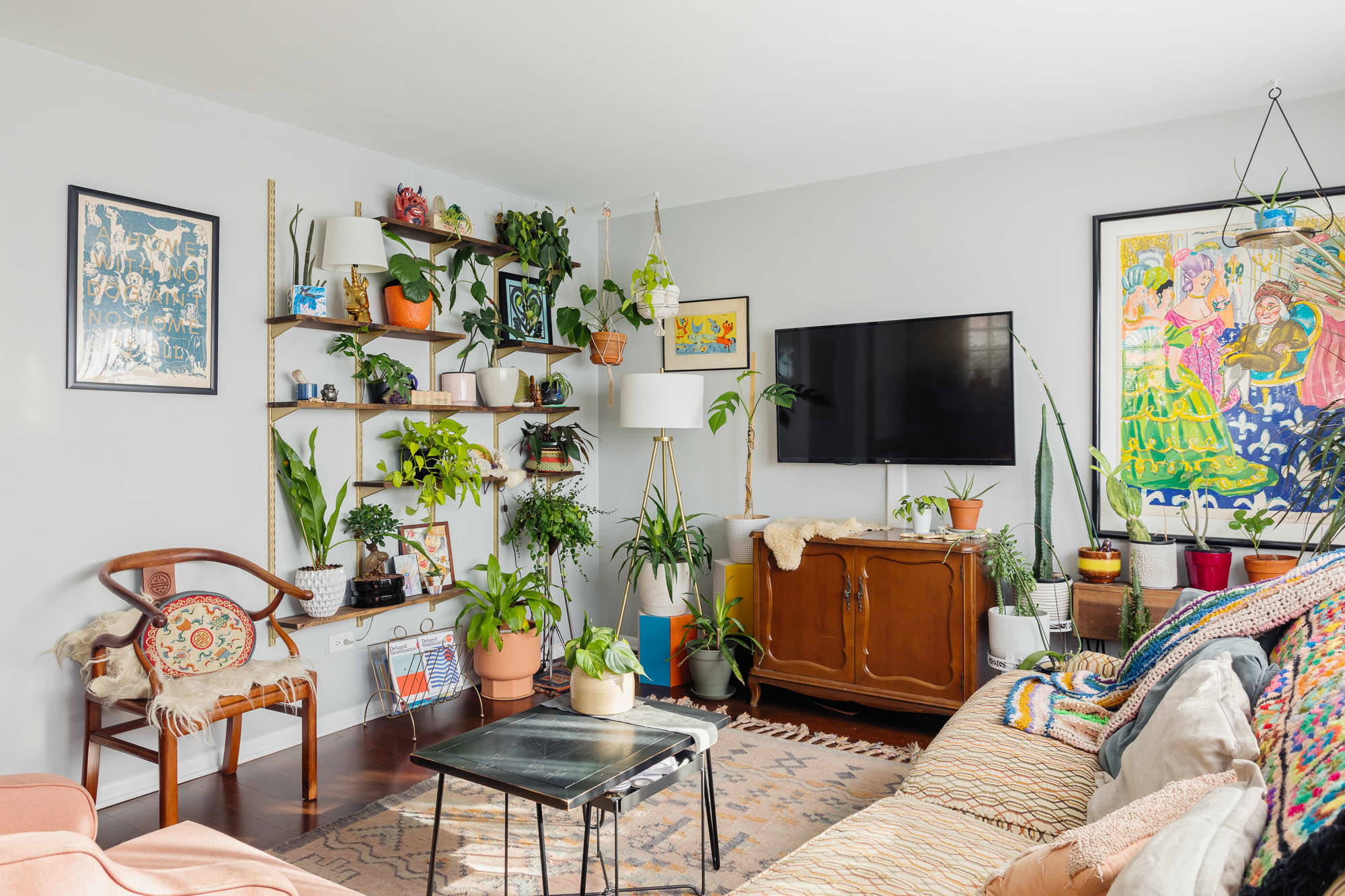
Mastering advanced plant styling techniques elevates your plant decorating from simple houseplant placement to sophisticated interior design that integrates seamlessly with your overall aesthetic vision. These techniques involve understanding how plants interact with architectural elements, furniture, and other decorative objects to create cohesive, professional-looking arrangements that enhance your home’s design while showcasing your plants to their best advantage. Advanced styling requires both horticultural knowledge and design sensibility, combining plant care expertise with aesthetic principles.
Layering represents one of the most effective advanced styling techniques, creating depth and visual interest through the strategic placement of plants at different heights and distances from viewing points. Successful layering involves understanding how different plant forms and sizes work together to create compositions that feel natural and abundant rather than sparse or scattered. This technique works particularly well in larger spaces where you have room to create complex, multi-level arrangements.
Foreground, middle ground, and background placement creates depth in plant arrangements similar to landscape design principles. Place smaller, more detailed plants in the foreground where they can be appreciated up close, medium-sized plants in the middle ground to provide substance and structure, and larger plants in the background to create backdrop and scale. This layering technique works particularly well in corners or along walls where you can create the illusion of depth and abundance.
Architectural integration involves using plants to enhance and complement your home’s structural elements rather than simply placing them as independent decorative objects. Consider how plants can soften hard edges, fill empty corners, frame doorways or windows, or create natural transitions between different areas of your home. This approach creates more sophisticated, built-in looks that feel intentional and professionally designed.
Framing techniques use plants to create natural borders or emphasis around other decorative elements like artwork, mirrors, or furniture pieces. Tall plants can frame seating areas or create natural room dividers, while smaller plants can highlight specific decorative objects or architectural features. Understanding how to use plants as framing elements helps create more cohesive, integrated design schemes.
Color echoing involves selecting plants and containers that repeat or complement colors found elsewhere in your room’s design scheme. This technique creates visual connections that make plant arrangements feel like integral parts of your overall design rather than added afterthoughts. Look for opportunities to echo wall colors, fabric patterns, or artwork hues through your plant and container selections.
Texture repetition creates visual harmony by repeating similar textures throughout your space using both plants and other decorative elements. For example, the rough texture of a jute rug might be echoed in woven plant baskets, while smooth ceramic containers might complement sleek furniture surfaces. This technique creates sophisticated, cohesive looks that feel professionally designed.
Scale progression involves arranging plants in size sequences that create visual flow and movement through your space. This might involve graduating from small tabletop plants to medium floor plants to large statement specimens, creating a sense of rhythm and progression that guides the eye through your arrangement. Understanding scale relationships helps create more dynamic, interesting plant displays.
Negative space utilization recognizes that empty space around plants is as important as the plants themselves in creating effective arrangements. Avoiding overcrowding allows each plant to be appreciated individually while creating breathing room that prevents arrangements from feeling cluttered or overwhelming. Strategic use of negative space creates more sophisticated, gallery-like presentations.
Seasonal styling adaptation involves adjusting your plant arrangements to reflect changing seasons while maintaining year-round appeal. This might involve rotating plants to different locations based on seasonal light changes, adding seasonal flowering plants as temporary accents, or adjusting container choices to reflect seasonal color palettes. This approach keeps your plant displays feeling fresh and current throughout the year.
Lighting integration considers how both natural and artificial light interact with your plant arrangements to create desired moods and highlight specific plants or features. Understanding how light moves through your space at different times of day helps you position plants for optimal visual impact while meeting their horticultural needs. Consider how evening lighting can transform plant arrangements and create different atmospheric effects.
Frequently Asked Questions
How do I know if my plant is getting enough light?
Monitor your plant’s growth patterns and appearance for signs of adequate lighting. Plants receiving sufficient light will maintain their natural color, produce new growth regularly, and maintain compact, healthy forms. Insufficient light typically causes stretching toward light sources, pale or yellowing leaves, and slow or stunted growth. If your plant is reaching dramatically toward windows or becoming leggy, it likely needs more light. Consider moving it closer to a window or supplementing with grow lights.
What are the best low-maintenance plants for beginners?
Snake plants, ZZ plants, pothos, and spider plants are excellent choices for beginners because they tolerate neglect and adapt to various light conditions. These plants can survive occasional missed waterings and don’t require frequent fertilizing or repotting. Rubber trees and peace lilies are also forgiving options that provide more dramatic visual impact while remaining relatively easy to care for.
How often should I water my indoor plants?
Watering frequency depends on the specific plant, pot size, soil type, humidity, and season. Rather than following a rigid schedule, check soil moisture by inserting your finger 1-2 inches into the soil. Most plants need watering when the top inch of soil feels dry. During active growing seasons (spring and summer), plants typically need more frequent watering than during dormant periods (fall and winter).
Can I use decorative pots without drainage holes?
Yes, but with careful technique. Use decorative pots as cache pots with properly draining inner containers, or create drainage layers using gravel and activated charcoal. Water carefully to avoid accumulation, and consider using a moisture meter to monitor soil conditions. Alternatively, drill drainage holes in decorative pots if the material allows, or choose plants like air plants or certain succulents that can tolerate containers without drainage.
How do I group plants together effectively?
Use odd numbers of plants (3, 5, 7) and vary heights, textures, and forms for visual interest. Ensure all plants in a grouping have similar light and water requirements for practical care. Consider the mature size of plants when planning groupings, and leave adequate space for growth and air circulation. Repeat colors or textures throughout the grouping to create visual harmony.
What should I do if my plant’s leaves are turning yellow?
Yellow leaves can indicate several issues. Check soil moisture first—both overwatering and underwatering can cause yellowing. If soil is consistently wet, reduce watering and ensure proper drainage. If soil is very dry, increase watering frequency. Some yellowing of older, lower leaves is natural as plants age. If yellowing affects multiple leaves or new growth, consider factors like nutrient deficiency, pest problems, or environmental stress.
How do I increase humidity for my plants?
Group plants together to create microclimates with higher humidity. Use pebble trays filled with water under plants, but ensure pots don’t sit directly in water. Run a humidifier near plant groupings, or place plants in naturally humid areas like bathrooms. Misting can provide temporary humidity increases but shouldn’t be the primary method, as excessive moisture on leaves can promote fungal problems.
When should I repot my plants?
Repot when plants become root-bound (roots circling the pot or growing through drainage holes), when soil depletes quickly despite regular watering, or when plants stop growing despite good care. Most houseplants need repotting every 1-3 years. Spring is typically the best time for repotting as plants enter their active growing season. Choose pots only 1-2 inches larger in diameter than the current container.
How do I deal with plant pests naturally?
Inspect plants regularly to catch pest problems early. For minor infestations, wash plants with a strong water spray or wipe leaves with a damp cloth. Insecticidal soap and neem oil are effective, natural treatments for most common pests. Increase humidity and ensure proper watering to prevent pest-friendly conditions. Quarantine new plants for several weeks before introducing them to your collection to prevent pest spread.
Can I keep plants in rooms with no windows?
Yes, with artificial lighting. LED grow lights can provide adequate light for many houseplants in windowless rooms. Choose full-spectrum LED lights and position them 6-12 inches above plants, running them for 12-16 hours daily. Low-light tolerant plants like snake plants, ZZ plants, and certain pothos varieties work best in these conditions. Consider the room’s function and choose plants that won’t interfere with activities.
How do I choose the right pot size for my plant?
Select pots 1-2 inches larger in diameter than the current container for most plants. The pot should be proportionate to the plant size—large plants need substantial pots for stability, while small plants can be overwhelmed by oversized containers. Ensure adequate drainage and consider the pot’s weight when filled with soil and water, especially for hanging or elevated displays.
What’s the best way to arrange plants in small spaces?
Utilize vertical space with wall-mounted shelves, hanging plants, and tall plant stands. Choose plants with upright growth habits rather than spreading varieties. Use corners effectively with tiered plant stands or ladder-style displays. Consider trailing plants that can cascade from elevated positions without taking floor space. Group small plants together for greater visual impact than scattered individual specimens.





